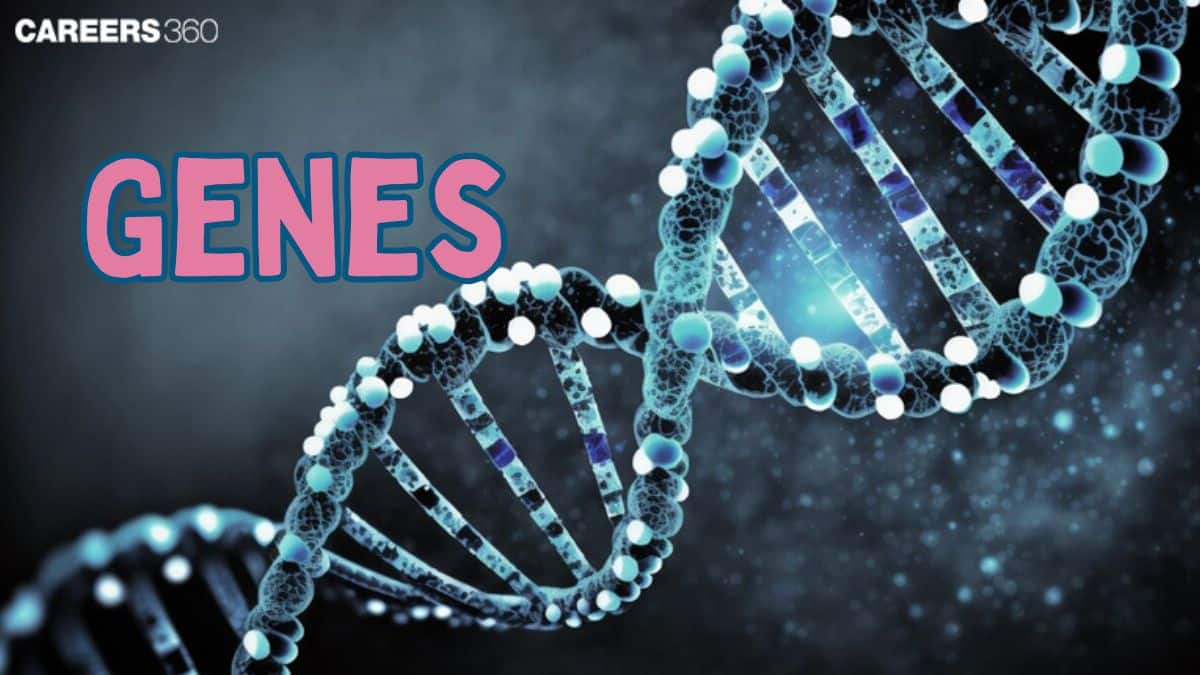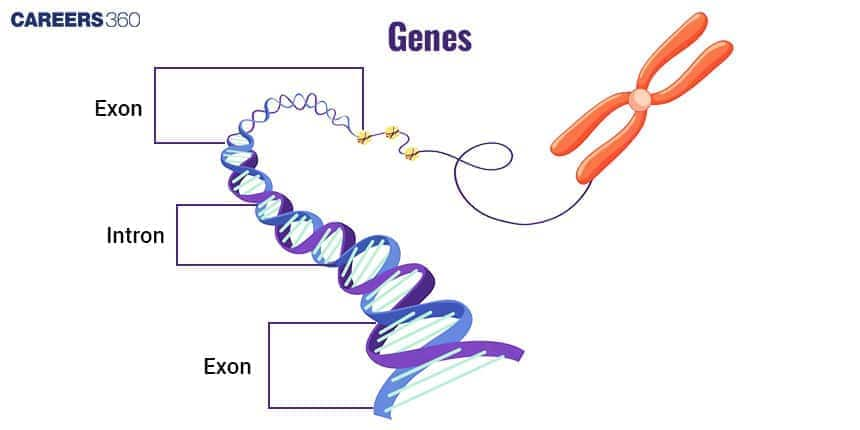Genes: Definition, Structure, Expression, Facts, Characteristics, Functions
A gene is the basic unit of heredity. Genes are made of DNA and are part of the cell’s genetic material. Each gene carries a specific genetic code. This genetic code is stored in the DNA sequence. Genes play a vital role in passing traits. The genetic material in DNA carries many genes in a row. These genes pass information from parents to offspring.
This Story also Contains
- What are Genes?
- Discoveries Related to Genes
- Characteristics Determined by Genes
- Structure of Gene
- Function of Genes
- Video Recommended on GenesMCQs on Genes

The function of a gene is to make proteins. Gene function depends on the correct genetic code. All genes are written in the DNA language. The genetic material helps express gene function. Without proper gene function, cells cannot work. The role of genes in biology is very important. Genes and their genetic code control life processes in biology.
What are Genes?
A gene, in biology, is the fundamental unit of heredity found in the DNA of living organisms. It consists of specific sequences of nucleotides that determine its structure, with regions such as exons, introns, and regulatory elements. They transfer that genetic material to the next generation.
The concept of a gene developed in the 19th century, though it began with Gregor Mendel. Mendel's pea plant experiments gave the very fundamentals of genetic inheritance that were later built upon by James Watson and Francis Crick. They described the structure of DNA in 1953.
Genes are responsible for determining the physical and functional features of organisms. They control everything from eye color to a predisposition to certain diseases, thus lying at the very core of biological research and medical study.
Discoveries Related to Genes
The study of genes has a long history. Many scientists made important discoveries over time. These findings helped us understand DNA, genes, and inheritance. They showed how traits are passed through generations. From Mendel’s experiments to the Human Genome Project, each step revealed new facts about genes. These discoveries form the base of modern genetics.
Gregor Mendel discovered the basic laws of inheritance. He showed that traits are passed by factors (now called genes).
Friedrich Miescher discovered DNA in leukocytes (white blood cells) (1869).
Walter Sutton linked genes to chromosomes (1902).
Thomas Hunt Morgan proved the chromosomal theory of inheritance, i.e., genes are on chromosomes, using fruit flies.
Griffith discovered the transforming principle in bacteria (1928).
Avery, MacLeod, and McCarty proved DNA is the genetic material (1944).
Provided DNA as genetic information in the Hershey and Chase experiment (1952).
Watson and Crick discovered the double helix structure of DNA (1953).
The Human Genome Project decoded all human genes (completed in 2003).
Characteristics Determined by Genes
Genes determine a broad spectrum of characteristics. They decide physical traits like height and eye color. Genes also control body functions and behavior. Each person has a unique set of genes. These genes are inherited from both parents. The genetic blueprint shapes how we look and act. All traits are based on information in genes.
Reasons for Hereditary
Heredity refers to the transmission of characteristics from parents to their offspring through genes. The genetic principle of heredity explains how traits are passed from parents to offspring through genes. In reproduction, genes mix and shuffle, creating diversity as well as maintaining the continuity of the features that govern a particular species. The heredity system ensures that the trait is transmitted from both parents to the offspring.
Structure of Gene
The structure of a gene explains how genetic information is stored and used. Genes are made of DNA, and sometimes RNA plays a role. They contain units called nucleotides that carry the code. These nucleotides form the language of genes. Genes also include exons and introns arranged in a specific order. Understanding the structure of a gene helps explain how traits are inherited. It also supports the central dogma of molecular biology.
DNA and RNA Complex: Genes comprise DNA, which stands for deoxyribonucleic acid, an acid containing genetic information. RNA stands for ribonucleic acid, important in translating information into proteins.
Nucleotides: The two nucleic acids, DNA and RNA, are composed of nucleotides, each consisting of a sugar molecule, a phosphate group, and a nitrogenous base. It is the sequence of the latter that carries the genetic information.
Organisation of Genes: Genes have exons and introns, in which the exons are portions of a gene that encode the central dogma of molecular biology and become part of the mature mRNA. The introns might be several thousand nucleotides that interrupt the coding sequence and are removed in the process of RNA maturation.
Diagram: Gene Structure
The diagram below shows the structure of genes with their components.

Function of Genes
The function of genes is to control life processes. Genes carry instructions stored in the genetic code. These instructions guide the making of proteins. The function of genes can be defined as:
Transcription and Translation
Proteins are synthesised by the genes through two principal processes: transcription, which copies genetic information from DNA to mRNA, and translation, where appropriate proteins are assembled with the genetic information on mRNA.
Role of Genes in Protein Synthesis
The genes describe ways for assembling amino acids into linear sequences of particular proteins, carrying out cells' structural and functional roles.
Genetic Code
A set of rules whereby information in DNA is translated into proteins. The code consists of a sequence of nucleotide triplets called codons that each represent a specific amino acid.
Video Recommended on GenesMCQs on Genes
Question: What is a gene?
A unit of heredity that is passed from parent to offspring
A type of protein that regulates gene expression
A section of DNA that codes for a specific protein
A type of RNA that carries genetic information
Answer: A gene is a specific sequence of DNA that encodes the information required to make a functional protein or RNA molecule. This sequence of DNA contains the instructions for the sequence of amino acids that make up the protein, as well as the regulatory sequences that control when and where the gene is expressed. These proteins perform various functions in the body, such as enzymes that catalyze chemical reactions, structural proteins that form the framework of cells, and signalling proteins that regulate cellular communication. Mutations in genes can lead to changes in protein function, which can result in genetic disorders or diseases. In summary, a gene is a fundamental unit of heredity that carries the genetic information necessary to produce a functional protein or RNA molecule.
Hence, the correct answer is option 3) A section of DNA that codes for a specific protein.
Question: Mendel proposed that ____ were being stably passed down, unchanged from parent to offspring these ____ pass through the gametes over the successive generations.
Genes
Genotypes
Factors
Alleles
Answer: Mendel, in his experiments, noticed that traits passed down from parents to offspring were occurring in discrete units he called "factors." Today, those factors are referred to as genes. He discovered every individual had two alleles for each trait, one inherited from each parent, and these alleles segregate during the making of gametes in a way that produces predictable patterns of inheritance.
Hence, the correct answer is Option 3)Factors.
Also Read:
Frequently Asked Questions (FAQs)
Techniques include CRISPR-Cas9 for the precision editing of genes, gene cloning to produce multiple copies of genes, and recombinant DNA technology for gene transfer into new organisms.
It is that segment of DNA containing the needed information for making proteins, which perform different functions in the body. Genes work by being transcribed into mRNA and then translated to protein.
Structural genes coding for proteins, regulatory genes that turn on and off gene expression, and housekeeping genes involved in basic cellular functions.
One mutation can alter the nucleotide sequence of a gene; sometimes it will then produce an altered protein. This could result in malfunctioning proteins causing diseases or may have no effects or even be beneficial.
Gene expression is the process by which the information in a given gene is used in the synthesis of proteins. It is regulated by several elements, such as transcription, epigenetic changes, and environmental signals.